Blue Bathrooms and White Cherries
Wednesday, May 31, 2006
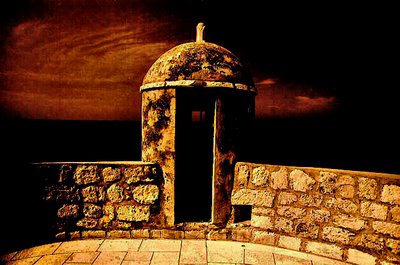

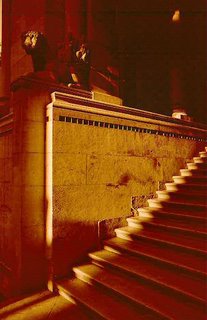
Years ago when Yugoslavia was Yugoslavia and Marshal Josip Broz Tito was in power I went on a tour with travel writer Garry Marchant. He had gone on enough travel junkets that It thought that nothing could really surprise him. But when we flew to Zagreb from Toronto, even Garry was surprised. I would define real "First Class" to be an airline that serves Champagne before you take off and is still serving it when you are landing. That was Yugoslavia Airlines. If I were to chose the four most beautiful cities of the world I would first start with Guanajuato, Mexico, Toledo in Spain, and Dubrovnik in Croatia. But I would eliminate the first two and settle for Dubrovnik (top, left). One reason is that in Dubrovnik you will find few Mexicans or Spaniards. In nearby island of Lokrum two things charmed me for loving the region. In 1859 Ferdinand Maximilian of Hapsburg was the owner of the island and he came for a visit. In his house they have kept an ash tray with ashes and the butt of one of his cigars. Maximilian became emperor of Mexico and was shot in 1867 by firing squad at the Cerro de Las Campanas in Querétaro, Mexico. It was in Lokrum where I had the sweetest cherries I have ever had. And they were a startingly white. While in Yugoslavia we also visited Split where I loved Diocletian's palace(right). We were taken to various houses owned by Tito but this one had the blue bathroom.
Ana Victoria
Tuesday, May 30, 2006
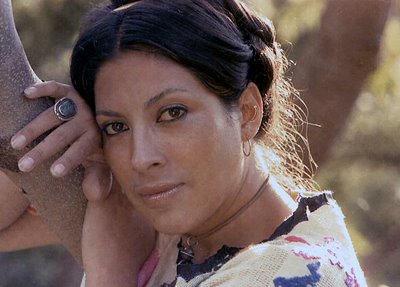
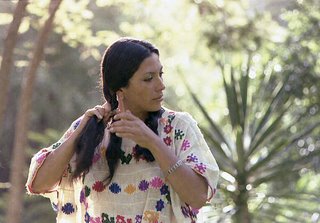
Rosemary, my daughters Ale (7) and Hilary (3) and I drove our Mexican VW Beetle from Mexico City to Vancouver in 1975. A roof rack had most of our belongings. Rosemary correctly decided that things weren't healthy in Mexico, at the time, for our daughters. Rosemary, who is from New Dublin, Ontario suggested that Vancouver was a better bet. She didn't think we would adjust to snow. In 1977 I still felt the pull of Mexico so I traded with Mexicana de Aviacion, tickets anywhere in Mexico in exchange for some slides. Some of the photographs that I took in Yucatán of Chichen Itzá, Tulum and Uxmal became my first published photographs in a long defunct Vancouver travel magazine. I went to Oaxaca where there was a week-long festival. I went to city hall to get my accreditation for taking pictures. The noisy hall held many photographers and writers lining up for the same accreditation. Suddenly there was silence in the room. A striking woman, dressed in native clothing and wearing lots of silver jewelry, walked into the room, past the long line and got her permit immediately. I enquired who she was and I was told she was the writer for the magazine Siempre. Siempre is a unique magazine that publishes articles from the political left and the political right. It has some intelligent editorial cartoons and most Mexicans (I can only speak for men here) read Siempre at the barber shop. I was impressed. While I was shooting some native dancers, the Siempre correspondent and an older woman kept getting in my way until I told them off. The older woman told me I was rude but both moved on. Later on when I was strolling in the zócalo I spotted the two women having lunch in an outdoor restaurant. I cannot understand exactly what happened but suddenly I was facing them and I heard myself telling the correspondent that I wanted to photograph her. She intrduced herself as Ana Victoria and told me that the other woman was her mother. She asked me to pass by her hotel after siesta.
She appeared in a a beautiful Oaxaca dress and it didn't take me long to realize she was wearing no underclothing. I attempted to take her pictures but was having a hard time. She said that she was in Oaxaca to educate native women on natural and herbal contraceptives. She told me she was flying in a small plane the next day for a rest at Puerto Escondido and asked me if I wanted to come along. I explained that I had a tight schedule and that I had to be in Merida that day. I declined. It was at this point that Ana Victoria told me something that I have never been able to forget or shake off.
"Most men are robots trying to pass as humans. Your tragedy is even worse. You are a human doing his best to be a robot. You are an extension of that device that you call a camera."
I never saw or heard of her again.
Siempre
Krzysztof Kieslowski - Blue-White-Red & Green
Monday, May 29, 2006

Polish director Krzysztof Kieslowski is best known for his Three Colour Trilogy (Blue-White-Red). My impression of him is based on another colour. To be precise, a deep green. I photographed him for the Globe & Mail on October 7, 1994. I watched gentle Christopher Dafoe (check blog for Saturday, May 27) interview him in the legendary (for me since I have photographed so many people there) Sun Room of the Hotel Vancouver. Kieslowski did not look well and he was chain smoking. I go this impression that he was not going to be around for long. A year later he had a heart attack and barely recovered. He died March 13, 1996. When I pulled out my deep green filter he looked at me and smiled. "I am a photographer, too," he said to me. "I know what a green filter does, exactly." And he posed for me and winked. As he looked straight into my camera I saw a man who was preparing to die. And I also knew, he knew, exactly, what the photograph was going to look like.
A Request Not To Be Refused
Sunday, May 28, 2006
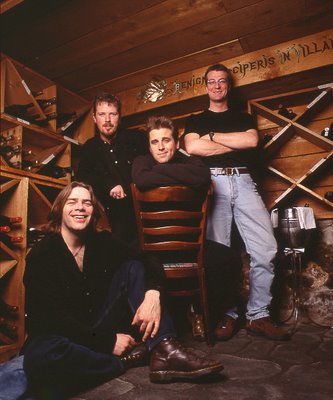
When Tony called me to ask me (in a New Jersey accent) to find a place quiet and private to meet with four guys, I knew I could not refuse.
I discovered the cellar of the Hamilton Street restaurant, Villa de Lupo (originally a house built in 1903), some years ago when Marc Destrubé the director of the Pacific Baroque Orchestra and I were shown to our table. The sound system was piping Antoni Vivaldi's Four Seasons - one of my musical pet peeves in restaurants - so I asked our waiter for a table without music. He led us downstairs.
Villa del Lupo's cellar is a real cellar, with shelved wine bottles surrounding the long oak table. The overhead roof is almost claustrophobically low. When the waiter closed the thick door behind him we were in a soundproof room, almost like a cell.
So when Anthony DePalma, the 1998 Canadian correspondent for the New York Times, called me with his odd request I knew just the room. The "four guys" turned out to be the touring members of the Newfoundland band, Great Big Sea.
As we six entered the wine cellar DePalma bowed his head to duck the beams that run the length of the 1.75-metre-high ceiling. The thick door was closed behind us. "Perfect," proclaimed DePalma.
Great Big Sea did not eat. On the New York Times's tab they drank single malt Scotch all evening. DePalma, a professional journalist of the highest standard, was not tempted by the Nonino's on the restaurant's special grappa list.
Elmore Leonard, Richard Margison & The Gentleman
Saturday, May 27, 2006
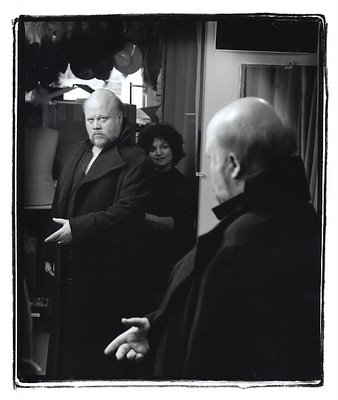
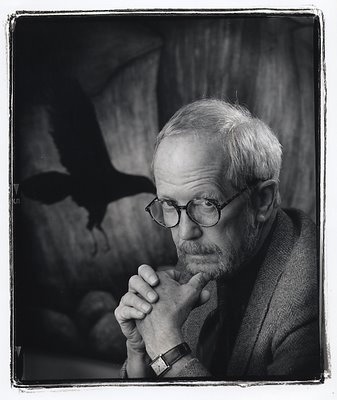
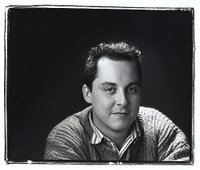
In 1997 I had to photograph for the Globe & Mail, Victoria tenor Richard Margison. He was in Vancouver in preparation for his role as Manrico in the Vancouver Opera production of Verdi's Il Trovatore. It was fun to watch him become Manrico while beeing fitted for his coat. The Globe arts writer, not an expert on opera, was Christopher Dafoe. I have worked with many writers in my 30 years in Vancouver and there are two qualities that Dafoe had that still stand out. Before I define those qualities I would like to point out that Dafoe is very much alive except that he is no longer a journalist. He graduated from the UBC Law School and he is now clerking at the Supreme Court. Chris's two qualities were his ability to say very little during interviews. His subjects opened up to this gentle technique. Watching Chris watch Elmore Leonard eat a hamburger at the Lazy Gourmet was special. Leonard forgot he was being interviewed. Dafoe was, above all, a kind man and a kind reviewer who never insulted any of his subjects in print. That is more that I can say about other local writers. One movie reviewer, over his head and confusing movies with opera, reviewed Margison's excellent Manrico for a local weekly. He called Margison a "beach ball with a toupee." When I read that I was ashamed to be a Vancouverite.
Silas Huckleback
Friday, May 26, 2006
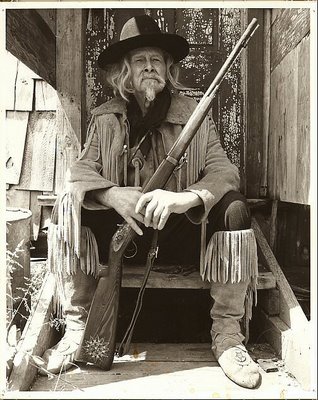
When I went to his funeral in 1980 they were playing Red River Valley at his request. After I photographed Silas Huckleback (aka Melvin Read Burritt) in 1978 I used to visit him (he lived near Mountain Highway in North Vancouver) with my two daughters who loved to see him dressed in his buckskins. While he looked like a genuine buffalo hunter, Silas was always up front in saying that he was born two years later that 1887 when the last bison where seen in Alberta. Silas survived Passchendale's trenches but was evacuated to England when a farmer caught him stealing a chicken and shot him in the rear with a shotgun. Silas always offered me (and I could not decline) his black raspberry wine. On his wall he had a little epithet that read
When the legends die, the dreams end.
When the dreams cease, there is no more greatness.
Jessie Richardson
Thursday, May 25, 2006
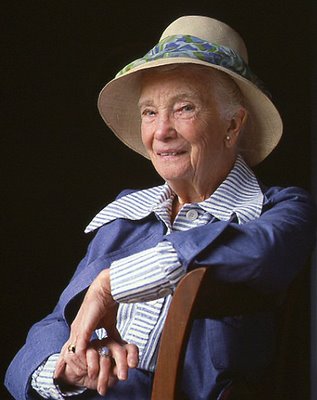
With all the talk and hype about the recent Jessie Award nominations I always think of the gracious lady I photographed in June 1978. She was 82 and her name was Jessie Richardson. She had been born in England and had come to Canada in 1919. She devoted the last 40 years of her life (she died in 1980) to theater. Her favourite roles where Miss Julie in Hedda Gabbler and Anfisa in Chekhov's Three Sisters. And, yes, she did invite me for a cup of tea.
Pamela Martin's Clam
Wednesday, May 24, 2006
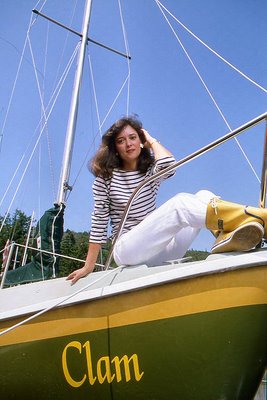
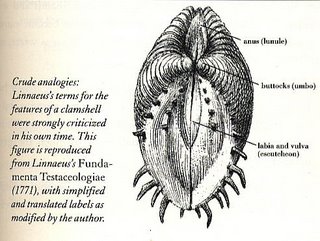
Vancouver Magazine editor, Mac Parry (aka Malcolm Parry) assigned me in May 1984 to find 6 interesting Vancouverites who happened to own boats for a summer themed June issue. I called my friend Alyn Edwards, car collector and restorer (specializing in convertible hardtop Fords, Meteors and battle ship gray T Birds) and BCTV newscaster and asked him if he knew anybody who owned a boat. "Pamela owns a boat but I cannot tell you if it is good one." So a few days later I made an appointment with Martin at a dock where she had her boat. I will never forget the occasion because of two details. While I was taking pictures of Martin I watched as my prime 50mm F-1.4 lens rolled off (in what I perceived as slow motion) the dock and into the sea. The second was the name of the boat. I asked Martin about it. She explained that her man at the time was called Clyde. "Combine Clyde and Pam and that's how you get to Clam," she said.
Quite a few years later, when Fanny Keefer had a radio talks show program, she invited me for an interview. She made that usual question of what person I had photographed that had made the most impression on me. I decided to be playful and said on live radio, "I want to tell you about Pamela Sue (yes!) Martin's Clam. Within seconds a man called into the show who said he had purchased the Clam and was very happy with it.
For an interesting explanation on the the origin of the sexual connotation of the clam to a woman's privates check page 79 of Stephen Jay Gould's Leonardo's Mountain Of Clams And The Diet Of Worms (1998, New York, Harmony Books). The illustration on that page is reproduced above.
The Midwich Cuckoos
Tuesday, May 23, 2006

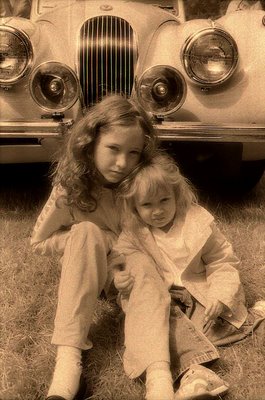
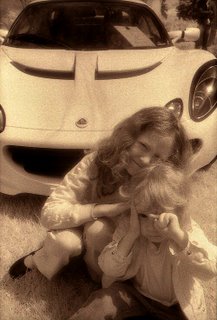
I was 24 and in Mexico City when Ingeniero Luis de la Rosa introduced me to Kodak b+w Infrared Film. He warned me to open the container and load the film only in absolute darkness. I ignored his instructions. I did not believe him when he said that the film would be fogged, as light would slide in through the felts into the cassette. He was right and I had to try again. He suggested that I use Kodak HC-110 to process the film instead of the usual D-76. I have worked with de la Rosa's formula all these years. Part of the tradition (which I started with my two daughters Hilary and Ale in 1978 ( top, Hilary, Rebecca and Lauren's mother, left and Ale, right) has been to photograph my granddaughters Rebecca and Lauren (bottom left and right) with this film. They come out with white lips (normal if I used purple based lipstick) and look like the child blond fiends from the Wolf Rilla film Village of the Damned. The film was based on the book by British science fiction writer John Wyndham, The Midwich Cuckoos. The book will always remind me of Ale's godfather, Andrew Taylor, who is from Yorkshire. He lent me his book in Mexico City and introduced me to the books of Wyndham. I saw the movie in the early 60s in the Israeli/Mexican Institute of Cultural Relations. Wolf Rilla was present and he explained that every frame of film (before digital special effects) had to be re-touched by hand so that blond children's eyes would make them look like fiends. Another reason to remember the film is George Sanders who had the lead adult part.
My friend Maanus Pikker invited us to the VanDusen Garden British Car Show on Saturday. Rebecca and I agreed that the best car in the show was the powder blue Jaguar (top left) and that the new Lotus Elise, top right was the only new car in the show that could in any way match the excitement of the old Lagondas and Aston Martins we saw.
John Wyndham
Village of the Damned
Infrared Photography
Tamara Taggart In Bed
Monday, May 22, 2006
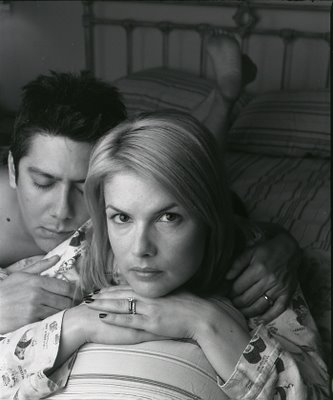
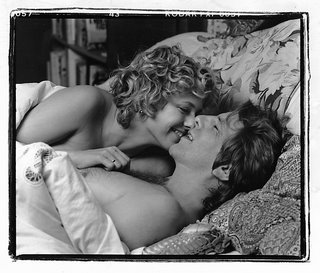

In 1992 during a Halloween evening at the Anza Club Art Bergmann and his band played dressed in drag. At the time I was preparing a one man show (a double one man show) in which I was going to display 50 photographs of Art Bergmann taken from the late 70s up to that time at the Red Dot Gallery on West Hastings. So I went back stage and took pictures of Art applying makeup, etc plus this one of the group. I also asked Art if he would pose with his wife Sherri in bed for me. He did. I was thrilled with the results.
A month ago Randall Watson, Vancouver Magazine's art director, assigned me to photograph Tamara Taggart. I made up my mind that I was going to photograph her in bed with her new husband Dave Genn. It took me a few minutes to figure out that I had photographed Dave back in 1992 at the Anza Club. That's Dave, at the bottom left with long hair. I also decided that I would do my best to have Taggart pose with the least amount of makeup. I wanted to make her look as different as possible from her CTV weathercaster look. Perhaps after I fired the Anza Club and the Art in Bed photos to Taggart via email, things were softened up a bit and I got what I wanted. Vancouver Magazine published a colour version of this b+w one.
The President
Sunday, May 21, 2006
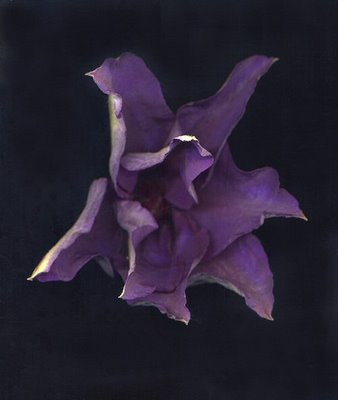
I cannot abide showy flowers that don't have scent. Most of my garden roses are fragrant. Rosemary is in charge of clematis since I have no interest in them. Most are scent free plus they are fragile and you have to know higher mathermatics (Rosemary does my income taxes) to find out when and how to prune them. The only clematis that I like is Clematis montana. This one is very fragrant. To me its scent is reminiscent of the sugar coating in the inside of Adams Chiclets squares. Not only that, but Clematis montana is an honarary bamboo. If you don't prune it back every few years it can bring down your house. The clematis above is Clematis 'The President'. It is even beautiful before the flower opens. Clematis is pronounced with emphasis in the first syllable. I often seriously ask the master gardeners (most are very correct older women) who have 'clinics' at local nurseries how they pronounce clematis. Their usual answer is with emphasis in the second syllable. At that point I ask them how to pronounce c-l-i-t-o-r-i-s. They shoo me away. The fact is that both words are emphasized in that first syllable.
A Holy Grail Prune Job
Saturday, May 20, 2006
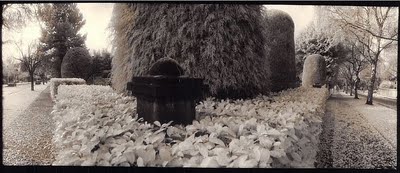
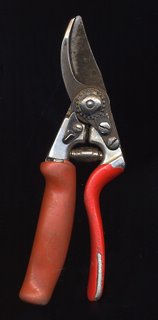
There is one garden chore that I am ambivalent about. This is my very long, wrap around, laurel hedge (Prunus lusitanicus). I have been pruning it since 1986. In 1992 I decided to achieve the "Holy Grail" of pruning by using only secateurs (above right). It took me a week. Since then I have found that if I do it now I only have to do it once in the year. I don't use electric hedge clippers as they don't cut off all the leaves or some of the thicker stems. These yellow in a few weeks and the hedge is unsightly. I use hand hedge clippers, which this year I had sharpened. It will take two days of this Victoria Day weekend.
Mystery Peony
Friday, May 19, 2006
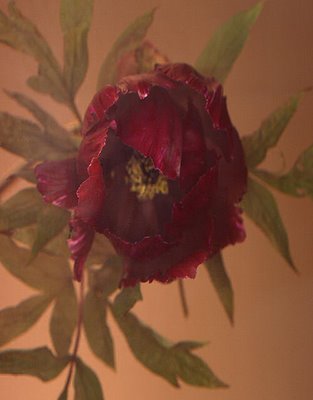
In the mid 1990s my neighbourhood was in flux. Older people who had gardened for years sold their houses which were then torn down to be replaced by bigger houses with smaller gardens that were supposed to be maintenance free. In those days contractors did not understand the value of the old plants in the gardens so I was able to remove many of them (with the contractors' blessing)and bring them home in a wheel barrow. There are many plants in my garden that remind me of the houses they came from or of the people who lived in them. I have a spirea from the garden across the street, where Mrs. Alm used to live. In hot summers, when the crows would make noise during her siesta, Mrs. Alm would come out and clap in a futile gesture as the crows never paid attention to her. My first hosta ever, a huge green one, came from a house on 43 Avenue and Hudson that had one of the most beautiful blue spruces I had ever seen. Since I have never found out its cultivar name of the hosta (probably Hosta 'Elata') I have always called it Hosta '43d & Hudson' For about 5 years an orange and red rose from Cartier Street had the name Rosa 'Cartier' until one day Brad Jalbert (from Select Roses in Langley) identified it as Rosa 'All That Jazz'. Rosemary has come to love it in spite of its lurid orange/red colour. Rebecca wants one. But one of the mystery guests of my garden is a peony tree that has very fragrant and large dark red flowers with white streaks. I know nothing about peonies so I have never identified it. In good years we got one to three blooms. A couple of years ago we had to remove a dying juniper hedge from the lane wall and since there is now a lot more sun coming in, the mystery peony is in full bloom today. I counted 12 flowers.
I find that I don't grieve for that beautiful blue spruce on 43d and Hudson Street. The new owners(who must have been young and patient) planted a Magnolia grandiflora. It has taken 10 years for the tree to grow and to finally bloom. The scent of Magnolia grandiflora's (called the Southern Magnolia) very large and very white flowers is sublime. Other scents I love are:
1. Rhododendron luteum
2. Rosa 'Fair Bianca'
3. old fashioned sweet peas
Select Roses
Rhododendron luteum
Thursday, May 18, 2006
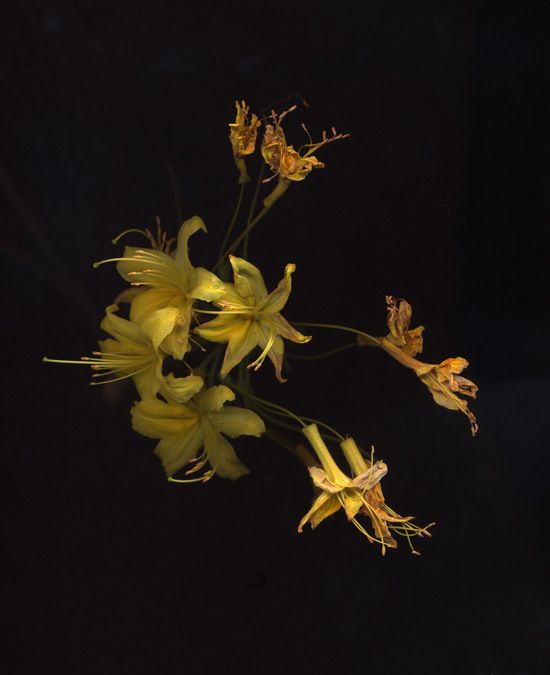
Rhododendron luteum was first described by Linneus in 1753 as Azalea lutea because of its yellow flowers. Recently azaleas, formerly thought to be first cousins of rhododendrons, have entered as full fledged rhododendrons and are no longer called azaleas. This scan of the flowers of the Rhododendron luteum from my garden show some spent flowers. I am showing them for a reason. The large tree-like bush (large because I calculate that my specimen must be 40 years old) begins to bloom around May 6 but by May 16 many of the flowers begin to wither. It is at this stage when the unusually sweet scent of luteum becomes even more so. The combination of a hot evening and the overipeness of the flowers is one of the spring pleasures of my garden.
The Toy Boat and the Manila Doll House
Wednesday, May 17, 2006
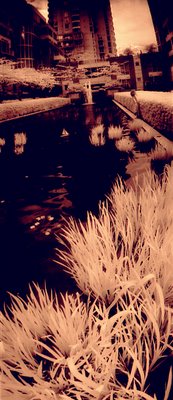
It was 1917 in Manila. About a month before my mother Nena had her birthday (she was going to be 6), her father, Don Tirso de Irureta Goyena took her to a toy store. They looked around and my mother eyed a beautiful doll house but said nothing. A few days before her birthday my grandfather died. He was 35. The day of Nena's birthday a messenger arrived with a big package for Nena. Nena opened it to find the beautiful doll house. In it was a card that said ,"To my daughter on her birthday from your loving father. Tirso. " My mother got up and shouted in with pleasure, "Papi is not dead. He just sent me a present."
As a little boy I had a toy sailing boat that was about 4ft long. My father gave it to me and I have fond memories of floating it around in ponds in Buenos Aires parks. I have no memory as to when it disappeared from my life. This week I took Rebecca to a development on Beach Avenue that has a pond. I borrowed a boat from architect Dale Rickard. Rebecca fell in love with the boat and said, "Suppose he gives me the boat?" I said that it wasn't going to happen as it is an antique. But there is no doubt in my mind what I have to get for Rebecca on her birthday in August.
Martin Sheen
Tuesday, May 16, 2006
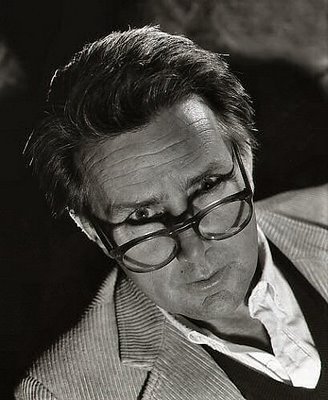
I met and photographed Martin Sheeen in October of 1988. He was in town to promote a thriller film called Coldfront. I remember that after the press conference he was surrounded by many journalists and I did not know how to isolate him from the crowd for a photograph. To make things worse in 1988 I was heavy into shooting with a spotlight and it was a cumbersome piece of equipment. So I faced Sheen and told him in Spanish, "¿Podria bajar sus gafas?" I used the castillian word for glasses "gafas" and I asked him to lower them. I knew that Sheen spoke perfect Spanish. He was so surprised to hear my Spanish that he stopped to pose for me. I got the glasses to cast shadows on his eyes exactly where I wanted. There are two films that are my favourite Sheen movies. Everybody knows about his role as Captain Benjamin Willard in Apocalpypse Now but few know that he was First Lt. Dobbs in Catch-22. I watch little TV so I have never seen the West Wing that aired its final episode this week. But I know that somehow Sheen picks his roles based less on the idea of how much money he can make and more on a character that has integrity, a virtue he seems to have in spades.
Jane Austin Coop - Muse
Monday, May 15, 2006
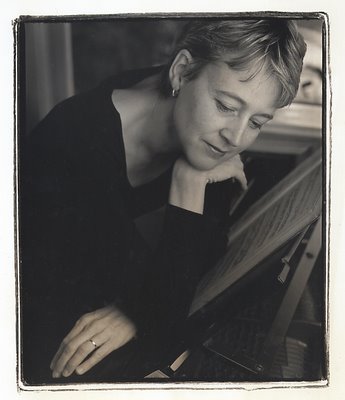
On April 8 I listened to Russian pianist Nikolai Maloff play Beethoven's Piano Concerto No. 1 Opus 15 C Major with the Vancouver Philharmonic Orchestra. I was five ft away and from my perspective I thought the piano was soon to collapse. My instincts were based on the fact that I had seen him work on the piano the day before. I had attended the dress rehearsal with my wife Rosemary and granddaughter Rebecca. During a moment, when the cellos were not playing, I watched one of the players play "air" piano with a smile on her face. I was surprised to see Jane Coop in the audience. She told me that Maloff was in her UBC piano program and that indeed he was as good a pianist as I thought.
Sunday I listened to a taped recording of a January 22, CBC Radio Two Westcoast Performance, hosted by Michael Juk. The program featured Daniel Chow on the piano. Early on Chow played Felix Mendelssohn's Allegro brilliant in A, Op. 92 for four hands. Chow played with a mystery partner whose initials Juk informed us were JC. The mysterious pianist was Jane Coop. It seems Chow had lots of fun playing the piano with her.
But it was his interpretation of the Bach / Busoni - Chaconne (from Partita no.2 in D minor for violin), BWV 1004 that made the hair on my arm stand up. I have a live performance of the Chaconne by Monica Huggett on baroque violin. I found Chow's version (also live and recorded in CBC's Studio One) no less "religious".
Busoni
Jane Austin Coop
Hydrangea quercifolia 'Snowflake'
Sunday, May 14, 2006
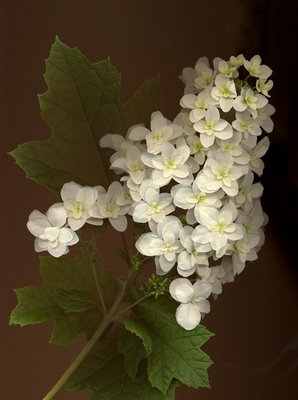
For at least 13 years, I have been going to the UBC Botanical Garden Mother's Day Plant Sale. It opens at 10 am but I line up around 7:45 so I can be in the front of the line and I have a good chance of getting the plants I want. This year, if things go as planned, I will be returning home with Hydrangea involucrata 'Hortensis'. This is a rare hydrangea cultivar rarely offered in the plant trade. I may have around 25 varieties of hydranges in my garden and I am most proud of Hydrangea serratifolia which is a species from Chile. I have a fondness for hydrangeas because they are the plants of my youth in Buenos Aires. Since Buenos Aires is in a similar latitude to South Africa many of the plants that grow in South Africa grow in Buenos Aires. Here in Vancouver it is warm enough that we can grow most hydrangea species. In my garden they can thrive in deep shade. Not mentioned in most plant books is the fact that many hydrangeas are fragrant and smell of honey. This is the case with Hydrangea quercifolia 'Snowflake'( a double flowered sport, above) which is from a species that thrives in the US South. As long as hydrangeas get lots of moisture during the growing season (no problem in Vancouver) they are carefree as they are not affected by pests. Unlike with roses, pruning these plants is very easy. Quercifolia means literally "like an oak leaf". Quercus is Latin for oak.
Madeleine Morris's Mouth
Saturday, May 13, 2006

My Spanish grandmother would have said, "She has the map of Jerusalem on her face." In retrospect I can see what drew me to Madeleine when I first spotted her face - the pale skin made even whiter by the contrast with her red lips - in the summer of 1985.
As a boy growing up in Mexico City I would stare at the darkish faces yelling a strange archaic Spanish from the inside of the orange school bus that passed by every day. On its side was the inegmatic message " Colegio Hebreo Sefaradita". Ever since, Sefaradites or Spanish Jews, have been a mixture of the exotic and the mysterious for me.
In Madeleine's face I can see apparitions of the past. In the deep shadows of her eyes, I see the little girl peering out from the left corner of El Greco's The Burial of the Count Orgaz hanging in the church of Santo Tomé in Toledo. In her cheekbones I see her ancestors praying in a tiny white sinagogue in Granada. Nearby, in an ornate cathedral, lie the lead caskets of the Catholic Kings who would exile them forever from Spain in 1942.
Madeleine was raised in Spain, and she always makes it a point to remind me of the source of power over me in her throaty and impeccable Castilian. As I photographed her in her tub, she said, while carefully pulling the top of her yellow and black '50s bathing suit, "I had to wear something, after all. It has to do with my Jewish sense of morality."
Marthe's Lovely Foot
Friday, May 12, 2006
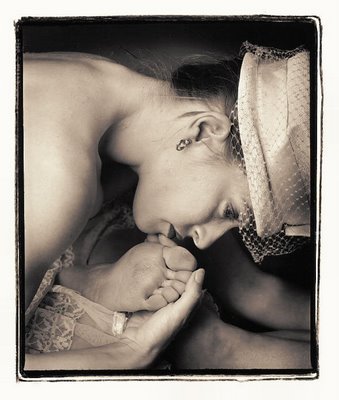


I first saw Marthe when I had to photograph a rehearsal of Jennifer Mascall's dance tribute to Emily Carr, The Brutal Telling, in October of 1998. The two dancers in the performance, Marthe and Olivia Thorvaldson both alternated dancing the character of Emily Carr, and Woo her pet monkey. I decided to photograph them in my studio and asked them to bring period clothing. I was astounded how, as soon as she had changed into the clothing, Marthe (bottom, right) seemed to have slipped into the present from Emily Carr's past. In a short chat I found out that Marthe was from Quebec and that she had danced for a short period for Ballet BC. I decided I wanted to photograph her again and she consented to return to my studio. In this portrait of Marth (above, left) I simply said that it was a pity the feet were so far from the face. "That's easy to remedy, " Marth told me. My Argentine tango teacher, Carlos Loyola gave her a couple of classes and he could not believe how quickly she caught on. I saw her dance the tango wearing fishnets and I can assure you she could have put many Argentine female dancers to shame. A couple of years later I found out Marthe mawent back to Montreal and I have not heard from her since.
Vancouver - Post Nuclear
Thursday, May 11, 2006

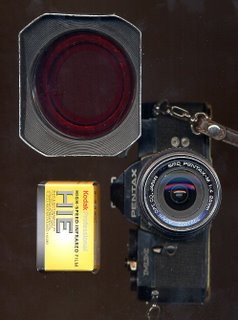
Just like the French drink Champagne between courses to cleanse the pallet I feel the same about shooting landscapes between portrait jobs. Landscapes don't close their eyes, they don't object and they are patient. On June 8 my landscapes will open a show at the Hong Kong Bank Pendulum Gallery. The show is called Secret Gardens and they are 12 gardens in the city that are on roofs or on podiums over the street level. The show is being put together by the "secret" Urbanarium Society and partially sponsored by the city. Here is a photo that would not make the cut as to me it looks like a horrific post nuclear apocalyptic image. I took it on the roof of the main branch of the Vancouver Public Library. I used a Pentax MX, a 20mm wide angle and Kodak Infrared film.
John Hurt In Bed
Wednesday, May 10, 2006
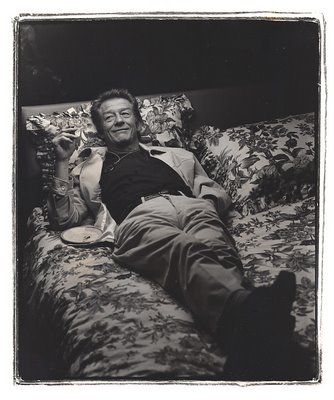
The past seems rosy at times precisely because it is rosy. Editorial photography has changed. There is less time so the there is less fun to it. Sometimes I photograph actors before the writers have inteviewed them, or worse still the art director assigns me to shoot an actor and does not offer to show me the writer's copy. Some art directors, who don't read, assume that we photographers don't need to either. But once in a while (and this was more often in my rosy past) I get to work in tandem with the writer. And sometimes it may be a writer I specially like. The picture above of John Hurt came about because writer John Lekich and I have worked together often. I don't think this photograph would have happened if I had gone alone. John and I knocked at the door of Mr. Hurt's suite at the Hotel Vancouver. The big room had a huge canopied bed. I asked Hurt to pose in bed or as Lekich wrote in the March 12, 1998 issue of the Georgia Straight, "When he's asked to pose for posterity on a hotel bed in a manner indicative of total pleasure, his craggy features suggest that this is the best idea he's heard all day. "I'm delighted to do exactly as you wish, "he says with a smile. "Really you mustn't hold back."
Miss Havisham & Isabel
Tuesday, May 09, 2006
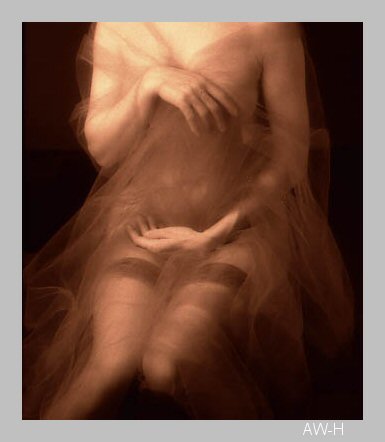
When I was 6 I fell madly in love with a remote Filipina girl in Buenos Aires called Isabel Opisso whom I met in an excursion to the outskirts of Buenos Aires in Anchorena. I never saw her again. A couple of years later our teacher read us Great Expectations in class during a month. I fell madly in love with cold and unreachable Estella.
In Dickens's Great Expectations Miss Havisham wears only one shoe, because when she learned that Compeyson had jilted her, she had not yet put on the other shoe. When I took this photograph of a friend, an Argentine tango partner, a few years ago I immediately saw Miss Havisham. I wonder where Isabel Opisso might be and if she ever married.
Jack Maggs
May June
Monday, May 08, 2006

May has to be one of the most exciting months in my garden. I go out to during the day and I can discern growth in some plants from one day to the next. This is particularly the case with my hostas. In May and in June they look fresh and perfect. None more so than Hosta 'June' (abover,right). Because I obtained my June from the American Hosta Society when June first entered the stage my specimen is an English one. The 'June' available in Vancouver in local nurseries is an American version which I don't find as attractive. 'June' is a sport (mutation) of Hosta 'Halcyon' which is the most handsome and elegant blue hosta. English gardener Eric Smith crossed a Hosta 'Sieboldiana Elgans' (it flowers in June) with a Hosta 'Tardiflora' (flowers in September) that just happened to bloom early one year. From that cross Smith obtained some of the best blue hostas ever (called the Tardiana Group) that share the blue colour of 'Sieboldiana Elegans' with the pointed leaves of 'Tardiflora'. Most have mauve flowers and thick substanced leaves that resist slug damage.
American Hosta Society
A Scottish Friend Indeed
Sunday, May 07, 2006

Try to find someone you know who is willing to sit down with you in the living room on a Saturday, for a four-hour stretch, to listen to a live Metropolitan Opera broadcast of Handel's Rodelinda. I would define such person a friend in much the same way only a friend will help you move. In my case it was easy. I invited Scottish designer, Graham Walker. Besides being a expert on sineage and typography (with a side interest in shoes and etching), Graham loves unusual and obscure music. His love is in the baroque period and both of us have discovered the wonders of the 17 Century early baroque, sometimes called the fantastic style period. We had never heard a whole rendition of Rodelinda so the prospect of hearing this one with soprano Renée Fleming and countertenor Andreas Scholl was too good to miss. Somehow both Rebecca and Lauren (3½)walked in and out of the living room so they got a bit of Handel. Plata, my female cat was partial to Handel, too as she sat on my lap. We ate what was left of lunch, deviled eggs and cucumber sandwiches which we washed down with a pot of strong Earl Grey. Graham brought some sweets.
Fantastic Style
Saturday, May 06, 2006
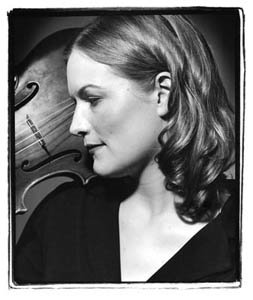
Last night's Pacific Baroque Orchestra's performance of The Young Romantics at St James Anglican on Cordova (the acoustics are phenomenal) was the kind of concert that even my poker-faced Argentine friend Juan Manuel Sanchez gave me an indication that somehow he was pleased. For him nothing will ever top what could happen at the Teatro Colón in Buenos Aires. His amazement became vocal when he heard Victoria's Alexander Dunn play Giulio Regondi's Reverie-Nocturne Op 19 on a pocket guitar called a terz guitar. There was something about Dunn's passionate coolness that reminded me of of Austin's punk/country Alejandro Escovedo. The concert began with Gioacchino Rossini's Sonata for Strings in C Major. As good as it was, alas, there were no violas! But the Kool Kat (above, a.k.a. Glenys Webster) and the Happy Bear, a.k.a. Steve Creswell were back for Mauro Giuliani's Concerto N0. 3 in F major Op 70 for guitar and strings. The beauty of this concert is that anybody who may read this can attend two more performances, one today and one tomorrow. An added bonus is listening to bassist David Brown, who has several little solos during the performance.

Last night's Pacific Baroque Orchestra's performance of The Young Romantics at St James Anglican on Cordova (the acoustics are phenomenal) was the kind of concert that even my poker-faced Argentine friend Juan Manuel Sanchez gave me an indication that somehow he was pleased. For him nothing will ever top what could happen at the Teatro Colón in Buenos Aires. His amazement became vocal when he heard Victoria's Alexander Dunn play Giulio Regondi's Reverie-Nocturne Op 19 on a pocket guitar called a terz guitar. There was something about Dunn's passionate coolness that reminded me of of Austin's punk/country Alejandro Escovedo. The concert began with Gioacchino Rossini's Sonata for Strings in C Major. As good as it was, alas, there were no violas! But the Kool Kat (above, a.k.a. Glenys Webster) and the Happy Bear, a.k.a. Steve Creswell were back for Mauro Giuliani's Concerto N0. 3 in F major Op 70 for guitar and strings. The beauty of this concert is that anybody who may read this can attend two more performances, one today and one tomorrow. An added bonus is listening to bassist David Brown, who has several little solos during the performance.
Friday, May 05, 2006

Some years ago I photographed a young woman who went by the name of Isis. She was very beautiful. I printed one of the negs and placed the print in the developer. The phone rang and I turned on the light. I quickly remembered I had a print in the developer tray. I turned it off, but not before the lovely damage had happened. This is called the Sabattier effect. The bright light on the developing paper somehow reverses the image partially. I don't think I could ever replicate this image if I tried.
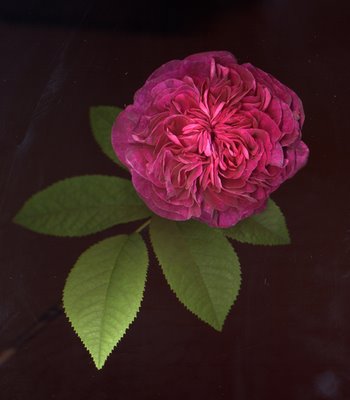
It only ocurred to me the other day that I have recently gone bonkers for gallica roses. I have ten varieties. The original species, Rosa gallica was native to southern Europe and eastward to the Caucasus. This wild rose is generally accepted to be the ancestor of the Damasks, Centifolias, Mosses and Albas. Unquestionably, Rosa gallica is in the lineage of practically all modern garden roses. Most modern garden roses are remontant. This means that after the initial flush of blooms in May/June the bushes repeat. Gallicas (sports and crosses of Rosa gallica with other roses) are not remontant. They make up for it by blooming in very large quantities. Why would I want to have these ancient plants in my garden? For one, the colours almost have no equal plus these roses, particularly the crimson ones "fade" into beautiful purples, greys and some get to an almost metallic silver tone. And their fragrance is superb. One such rose is Rosa 'Charles de Mills'. When the dense and quartered blossoms (they look like textured velvet) open they appear as if someone cleanly snipped a section off with a razor. I can't wait.
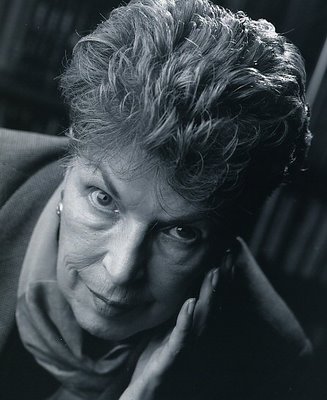
In my previous post I relate how Paco Ignacio Taibo II played a trick on me and never told me about it. He left it up to me to one day to find out. Fortunately I did. Being flummoxed by writers did not stop there. In 1996 I walked into Mystery Merchant (it used to be on 4th Avenue and it specialized in mystery and crime books). I asked for the lastest P.D. James book. A very serious and scary woman came up to me and said, "Here it is." From another corner the owner of the store noticed me and said, "You are here just in time this is Ruth Rendell. Do you have your cameras with you?" I did so I retrieved them and photographed Ruth Rendell. I broke my cardenal rule for author photos which is to never photograph one without at least reading one of their books. I asked her about her friendship with P.D. James and that was the only time she cast a smile in my direction. I asked her, "Are you always this serious and scary?" She answered that with a, "Yes." I have never known if that was true.
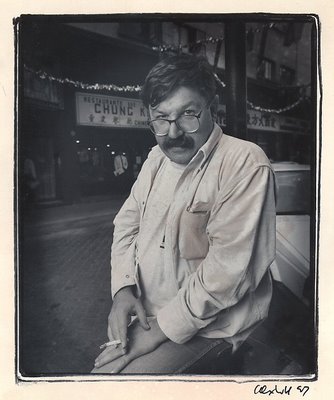
Magic realism as a concept applied to literature was introduced by Cuban writer Alejo Carpentier as "lo real maravilloso" is his prologue to his novel El Reino de Este Mundo, 1949 (The Kingdom of this World). In 1956 he wrote a novella El Acoso, The Chase in which all the bloody actions occur precisely during a 46 minute long performance of Beethoven's Third Symphony (Eroica).
In 1907 I travelled to Mexico City to interview and photograph Spanish writer Paco Ignacio Taibo II. His house was a block away from Tamaulipas Avenue where I had lived in the mid 50s. Taibo's house was mere yards from a roof on Veracruz Avenue where Edward Weston had photographed a nude Tina Modotti in the 1920s. In his study, early in the morning, Taibo sat me on the opposite side of his desk and then pressed his remote. Beethoven's Ninth Symphony began. "Let's start," he said. About 50 minutes later when the symphony ended, Taibo got up and said, "That's it." We met in the afternoon in the two block long Calle Dolores which is the city's minute China Town. It was there that I took my photo of Taibo II (above).
I did not get it until 1998 when my interest in Latin American Literature (perhaps precipitated by all those Taibo II novels that I had read) led me to discover the works of Alejo Carpentier. In the short story Viaje a la Semilla (Journey Back to the Source) everything happens backwards (the candles get longer during a wake). In Los Pasos Perdidos (The Lost Steps) the narrator loses his hope in mankind while listening to Beethoven's Ninth Symphony. But the bells did not ring in my head until I associated it all with Carpentier's novella "El Acoso". It was only then that I appreciated Taibo's trick at my expense!

Some years ago I photographed a young woman who went by the name of Isis. She was very beautiful. I printed one of the negs and placed the print in the developer. The phone rang and I turned on the light. I quickly remembered I had a print in the developer tray. I turned it off, but not before the lovely damage had happened. This is called the Sabattier effect. The bright light on the developing paper somehow reverses the image partially. I don't think I could ever replicate this image if I tried.
Unremontant Charles de Mills
Thursday, May 04, 2006

It only ocurred to me the other day that I have recently gone bonkers for gallica roses. I have ten varieties. The original species, Rosa gallica was native to southern Europe and eastward to the Caucasus. This wild rose is generally accepted to be the ancestor of the Damasks, Centifolias, Mosses and Albas. Unquestionably, Rosa gallica is in the lineage of practically all modern garden roses. Most modern garden roses are remontant. This means that after the initial flush of blooms in May/June the bushes repeat. Gallicas (sports and crosses of Rosa gallica with other roses) are not remontant. They make up for it by blooming in very large quantities. Why would I want to have these ancient plants in my garden? For one, the colours almost have no equal plus these roses, particularly the crimson ones "fade" into beautiful purples, greys and some get to an almost metallic silver tone. And their fragrance is superb. One such rose is Rosa 'Charles de Mills'. When the dense and quartered blossoms (they look like textured velvet) open they appear as if someone cleanly snipped a section off with a razor. I can't wait.
Ruth Rendell, A Scary Woman
Wednesday, May 03, 2006

In my previous post I relate how Paco Ignacio Taibo II played a trick on me and never told me about it. He left it up to me to one day to find out. Fortunately I did. Being flummoxed by writers did not stop there. In 1996 I walked into Mystery Merchant (it used to be on 4th Avenue and it specialized in mystery and crime books). I asked for the lastest P.D. James book. A very serious and scary woman came up to me and said, "Here it is." From another corner the owner of the store noticed me and said, "You are here just in time this is Ruth Rendell. Do you have your cameras with you?" I did so I retrieved them and photographed Ruth Rendell. I broke my cardenal rule for author photos which is to never photograph one without at least reading one of their books. I asked her about her friendship with P.D. James and that was the only time she cast a smile in my direction. I asked her, "Are you always this serious and scary?" She answered that with a, "Yes." I have never known if that was true.
Beethoven's Ninth, Third & Paco Ignacio Taibo II
Tuesday, May 02, 2006

Magic realism as a concept applied to literature was introduced by Cuban writer Alejo Carpentier as "lo real maravilloso" is his prologue to his novel El Reino de Este Mundo, 1949 (The Kingdom of this World). In 1956 he wrote a novella El Acoso, The Chase in which all the bloody actions occur precisely during a 46 minute long performance of Beethoven's Third Symphony (Eroica).
In 1907 I travelled to Mexico City to interview and photograph Spanish writer Paco Ignacio Taibo II. His house was a block away from Tamaulipas Avenue where I had lived in the mid 50s. Taibo's house was mere yards from a roof on Veracruz Avenue where Edward Weston had photographed a nude Tina Modotti in the 1920s. In his study, early in the morning, Taibo sat me on the opposite side of his desk and then pressed his remote. Beethoven's Ninth Symphony began. "Let's start," he said. About 50 minutes later when the symphony ended, Taibo got up and said, "That's it." We met in the afternoon in the two block long Calle Dolores which is the city's minute China Town. It was there that I took my photo of Taibo II (above).
I did not get it until 1998 when my interest in Latin American Literature (perhaps precipitated by all those Taibo II novels that I had read) led me to discover the works of Alejo Carpentier. In the short story Viaje a la Semilla (Journey Back to the Source) everything happens backwards (the candles get longer during a wake). In Los Pasos Perdidos (The Lost Steps) the narrator loses his hope in mankind while listening to Beethoven's Ninth Symphony. But the bells did not ring in my head until I associated it all with Carpentier's novella "El Acoso". It was only then that I appreciated Taibo's trick at my expense!
Monday, May 01, 2006
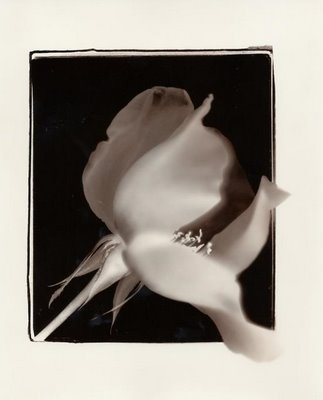
Hilary, my daughter, and Rebecca's mother called last night to tell me that she didn't think that Rebecca should keep at home the roses I bought for her at the VanDusen Plan Sale yesterday. "We would not know how to take care of them." But I insisted that Rosa 'Mrs. Oakley Fisher' (left), 'Tuscany Superb', 'Ballerina' and the miniature 'Green Ice' would probably take care of themselves just fine with a miniumum of help. Rebecca should learn not only the responsibility of having a pet (she has an orange cat called Raúl) but she should deal with botanical extinction as most adults gardeners do. Plants die, but more often than not, they thrive in spite of human care. Rebecca has successfully grown the English Rose, Rosa 'Mary Magdalene' for two years so these will not challenge her. The miniature rose 'Green Ice'so called because as the white flowers age, they turn a lime green, seems to be her favourite of the moment. It could be because it was already in bloom. Rebecca immediately re-named it Genevieve. At the the plant sale, rosarian Christine Allen told me, "We kept this very odd rose for you since you like odd things. It is hardly listed anywhere and it has a very strange mottling. It's called Rosa 'Soleil Brilliant'. She was right. It is not listed in any books and I was only able to find it on the net when I typed in Gallica rose, 'Soleil Brilliant'. Rebecca will be the first to know exactly how odd that mottling is going to be.

Hilary, my daughter, and Rebecca's mother called last night to tell me that she didn't think that Rebecca should keep at home the roses I bought for her at the VanDusen Plan Sale yesterday. "We would not know how to take care of them." But I insisted that Rosa 'Mrs. Oakley Fisher' (left), 'Tuscany Superb', 'Ballerina' and the miniature 'Green Ice' would probably take care of themselves just fine with a miniumum of help. Rebecca should learn not only the responsibility of having a pet (she has an orange cat called Raúl) but she should deal with botanical extinction as most adults gardeners do. Plants die, but more often than not, they thrive in spite of human care. Rebecca has successfully grown the English Rose, Rosa 'Mary Magdalene' for two years so these will not challenge her. The miniature rose 'Green Ice'so called because as the white flowers age, they turn a lime green, seems to be her favourite of the moment. It could be because it was already in bloom. Rebecca immediately re-named it Genevieve. At the the plant sale, rosarian Christine Allen told me, "We kept this very odd rose for you since you like odd things. It is hardly listed anywhere and it has a very strange mottling. It's called Rosa 'Soleil Brilliant'. She was right. It is not listed in any books and I was only able to find it on the net when I typed in Gallica rose, 'Soleil Brilliant'. Rebecca will be the first to know exactly how odd that mottling is going to be.






